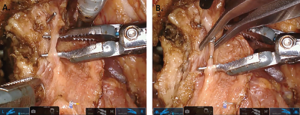Isolation of small branching vessels with da Vinci Sp dual-forceps dissection. (A) The Maryland forceps (left) are providing traction and the fenestrated bipolar forceps (right) are being used to isolate a small branching vessel within the deep tongue musculature. The cautery spatula (top) is being used as a blunt retractor to provide slight counter traction. (B) The vessel has been isolated and is being controlled with surgical clips that are placed by the bedside assistant.
© 2017 The American Laryngological, Rhinological and Otological Society, Inc.
